
by Gideon Marcus
The Interplanetary Pioneers
When you think "outer space", you don't usually think of weather. In fact, weather in space is a bit like weather on Earth: there's wind, turbulence, a steady rain, and occasional storms. Except that the wind and rain are the sun's ceaseless spray of charged particles along with their attendant magnetic fields. The storms are the result of solar flares, those sudden unsettled periods when fiery prominences reach out from the sun's surface.
These phenomena can even be sensed by humans—as aurorae where the solar wind interacts with the Earth's magnetic field, and as the crackle of static on a shortwave radio. For satellites and space travelers, the solar radiation, particularly during flares, can damage electronics and internal organs. There are thus a lot of reasons it would be practical to have a space weather report, just as we have a daily weather report down here on Earth.

Northern Lights, 1921, by Sydney Laurence
This is why the Pioneer series of solar weather satellites, the first launched December 16, 1965 and the latest launched on November 8th of this year, was created: to serve as long-term weather sentinels in space, the interplanetary equivalent of our TIROS weather satellites.
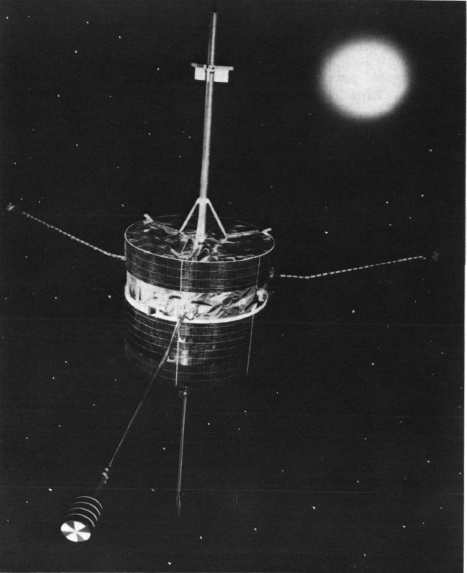
Prior to the launch of Pioneer 6 (no relation to Pioneer 5 or its predecessors save for the name), the mapping of the solar wind had been a strictly local affair. The Interplanetary Monitoring Platform satellites, Explorers 18, 21, 28, 33, 34, and 35, have all been launched in high Earth orbits to survey the solar wind between the Earth and the moon. This is in service of the Apollo program.
The aforementioned Pioneer 5 and interplanetary probes like Mariner 2 have made preliminary forays into true interplanetary space beyond the Earth/moon region, but those missions only lasted a few months. The interplanetary Pioneers will be on station for years.
Launched on Delta rockets (the direct descendants of the Thor-Able rockets that launched the first Pioneers toward the moon), Pioneers 6-9 (and eventually #10, next year), were hurled into orbits that parallel our own, but further out in the case of Pioneers 7, 8, and 9; a little closer to the sun in the case of Pioneer 6. The outer ones orbit a little more slowly while P6 zooms a little faster. As a result, they all spread out, making a necklace of stations around the sun.
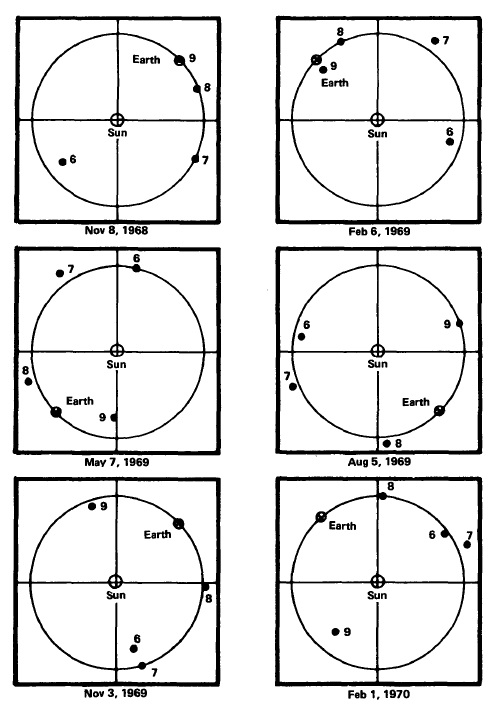
Pioneer 6 was launched in 1965 during the lull in the sun's 11 year cycle called "the solar minimum". The hope was that we would get continuous data as the sun increased in activity, flaring more and more often. We have not been disappointed. On July 7, 1966, a big shock front from a solar flare enveloped Explorer 33. 45 hours later, Pioneer 6 was hit. Interestingly, because of the time delay, even though both probes were similar distances from the sun (but far apart in orbit, of course), it is believed those might have been the result of two different flares, or perhaps two disturbances from the same one.
When the Pioneers were launched, scientists had a basic idea of that the solar wind looked like the spiral spray of a sprinkler head, this caused by the 28-day rotation of the sun. But the instruments onboard the sophisticated Pioneers afforded much more detailed analysis of these streams and fields. The Pioneers have found that the local magnetic fields will suddenly flip every so often. Their microstructure is like woven filaments, far more complicated than we had previously conceived.
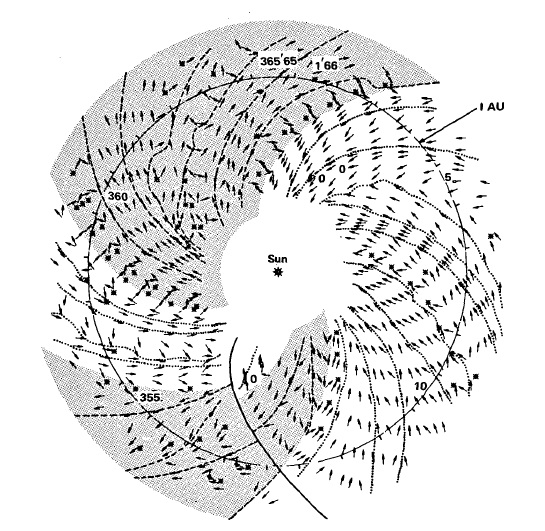
High-level view of the "sprinkler" spray of the solar wind
Pioneers 7 and 8 sailed through the Earth's magnetosheath, that magnetic shadow formed as the sun's wind interacts and deflects around the Earth. Comparing their results to the closer-in Explorer 33, they found that this shadow tail gets more diffuse, more like the background interplanetary wind at greater distances, which is what one would expect.
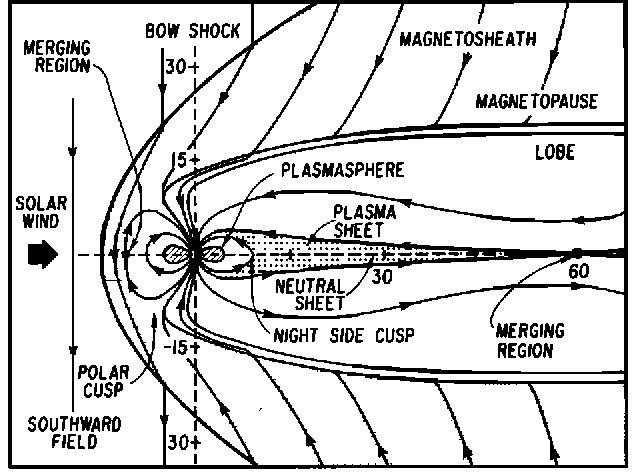
The Earth's magnetic field (you can see the figure 8 Van Allen Belts) and the long, trailing, magnetosheath.
The Pioneer satellites are well-placed for more than just solar science. Pioneers 8 and 9 are equipped with cosmic-ray telescopes designed to measure the chemical composition and sprectra of the galactic wind—the higher-energy rain of particles from beyond our solar system. But the coolest use of the Pioneers so far (to me) is when Pioneer 7 was used to measure the lunar ionosphere. On January 20, 1967, the moon "occulted" (blocked) the space probe, as seen from Earth. Radio waves were beamed from a 150-foot dish run by Stanford past the edge of the moon. They found that the scattering that resulted can't be explained just by the physical rocks of the lunar surface. There must be a tenuous "atmosphere" above the moon, at least on the sunlit side, created at high altitudes by interactions between the solar wind and the surface of the moon.
There's actually a lot more, esoteric stuff that's way above my head. And there will be plenty more as the Pioneers will probably keep going for many more years. Though they haven't gotten much press, I think these are some of the most exciting missions to date. Stay tuned!
My, what big…rockets you have!
Three years ago, I made a brief announcement about the launch of a new Soviet probe, one so enormous that its size alone had ramifications for the future of the Communist space program. Proton, launched July 16, 1965, massed a whopping twelve tons, making it the biggest single object put in orbit until the November 1967 launch of Apollo 4. That means that the USSR has a Saturn-class rocket in its stable, which is why the concerns about an imminent moon mission have grounding.
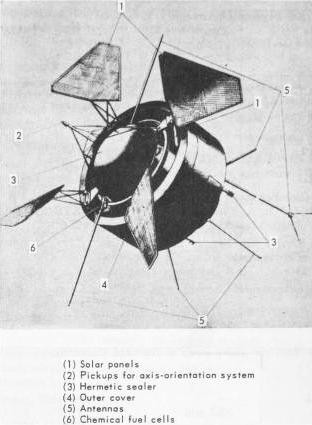
Since Proton 1, three more Protons have been sent into orbit, the latest just two days ago on November 16th. Proton 4 weighs seventeen tons, which will beat all records—at least until Apollo 8 goes up in December.
Why are they so heavy? Because they carry heavy instruments. Protons 1 and 2 included a gamma-ray telescope, a scintillator telescope, and proportional counters. These counters were able to determine the total energy of each super-high energy cosmic particle individually, a capability no prior satellite had possessed, measuring cosmic rays with energy levels up to 100 million electron volts.
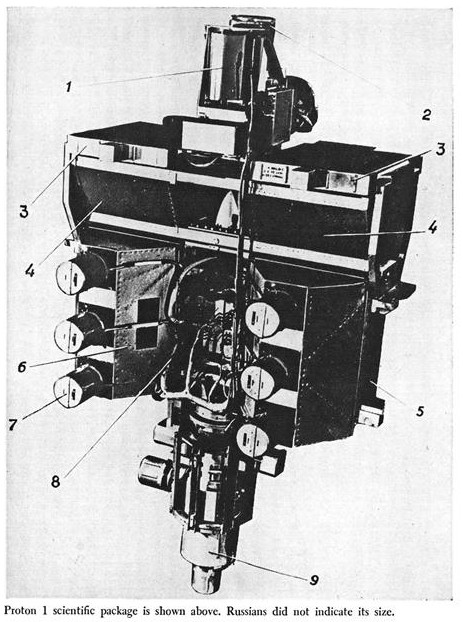
In addition to the above equipment, the fourteen ton Proton 3 was also equipped with a two-ton gas-Cerenkov-scintillator telescope. Its goal was to attempt to detect the "quark", a brand new theoretical sub-particle that, according to theory, makes up all atomic particles. Presumably, Proton 4 mounts a similar device with refinements.
Unlike most Soviet satellites, whose missions are shrouded in secrecy, data from the experiements onboard the first two Protons have produced at least five scientific papers on cosmic rays. I haven't seen anything on Proton 3, but astronauts on Gemini 11 managed to snap a picture of it in September 1966!
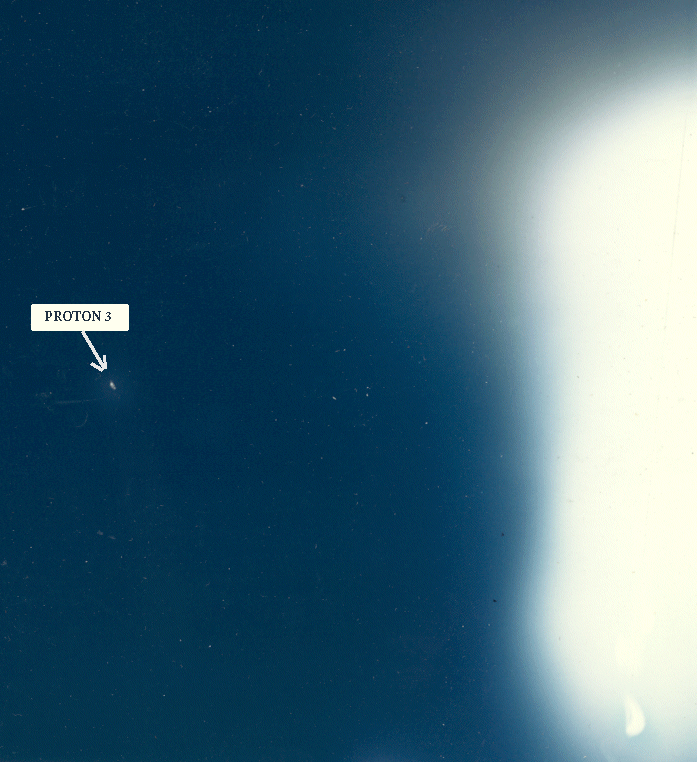
Will the advanced experiments on Proton 4 produce a scientific bonanza to rival that of the Pioneers? Only time will tell. For now, the papers are more obsessed with the rocket than the satellite.
Apparently, it's all about size. Who knew?



![[November 26, 1969] From the Earth to the Moon…and back (Apollo 12)](https://galacticjourney.org/wp-content/uploads/2024/11/691126crew-672x372.jpg)
![[November 18, 1968] Pioneers and Protons (a space round-up)](https://galacticjourney.org/wp-content/uploads/2023/11/681118aurora-672x372.jpg)









